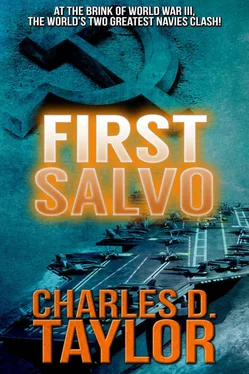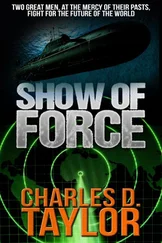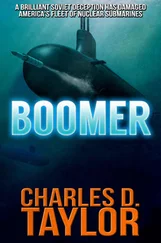By the time Carleton was seated at his station in CIC, his appearance was no different than when he left. He was one of those men who could put on a freshly pressed, custom-fitted uniform and ten minutes later appear as if he’d slept in it. His slacks were rumpled, the buttons on his shirt strained over his more-than-ample belly, and his belt had once again eased itself below his midsection. He was definitely not material for recruiting posters. But nothing in his outward appearance could have adversely affected the crew of Yorktown. He understood what sailors respected and what they reacted to — and they were on his side.
The computer could have told Carleton how long it would take for the two opposing forces to meet. Kharkov and her escorts were a little over two hundred miles to the east.
Both groups were making about twenty-five knots, closing in at more than fifty miles each hour. In four hours, they would be on top of each other. In two hours or less, though they would not yet be in sight of each other, they would be within shipboard missile range.
The proximity of the opposing surface forces to each other would have meant a great deal in the early stages, if they had been the main elements. However, there were submarines capable of moving much faster than the ships on the surface that could alter the situation at any moment. Some of the subs had not been detected since the satellite-intelligence capability had been lost. The overwhelming influence in the modern theater of war was the air-to-surface missiles. At any time now, they could be on their way with some probability of a hit. As each second passed, the odds increased that the initial missiles of the salvo would be launched.
The link with perimeter aircraft disclosed a large number of Soviet aircraft breaking through the barrier. The picture was revealed clearly on both Yorktown and Kennedy. Though Pratt and Carleton were in direct contact, their responsibilities differed considerably. The Admiral was in charge of overall strategy. Carleton was to coordinate the defense of Kennedy ’s battle group.
The red light on Carleton’s console winked in concert with the buzzer that sounded through CIC, and within seconds of the warning that the attack had commenced, a voice in the darkened room announced to no one in particular, “Missiles away!” It had begun.
There was a perceptible sigh in CIC, a collective release of tension. The waiting was over. Now they could act.
“Time to impact — twenty-four minutes.” The voice was cold, impersonal. It was the speaker’s job to announce the information, even if others could note the time simply by pushing a button.
A tactical signal came over the primary voice net for all ships. On their direct line, Admiral Pratt said, “Tom, I’m shifting the screen around, moving everybody a bit. No reason to make it easy for them. I want you to act independently. There are two of their Alfa-class subs out here that we’ve completely lost.” Those were titanium-hulled attack subs, extremely fast, unusually quiet, and their hull alloys did not distort the magnetic field — making them even harder to locate.
“Probably went silent,” Carleton responded.
“That’s exactly what my man Loomis figures. They could pop up anywhere.”
Carleton gave his executive officer free reign to conn the ship. The ship’s movements made no difference to the computer as long as it continued to provide the necessary functions to back up the system’s operations. Able to detect and track a couple of hundred targets at a time, it now would face its greatest test. The Soviet Backfires were filling the air with missiles, some fired from maximum altitude, others from lower levels. Some of the bombers swooped down to sea level to release their missiles below the acquisition level of most shipboard radars. And there were a select number of bombers in each flight that retained their weapons. They would continue to close in on the group, conducting evasive action so that some of them might get close enough to fire at point-blank range — close enough to penetrate the security envelope that allowed ships’ computers time for a target solution for their own defensive missiles.
Dale , one of the perimeter anti-air-defense ships, was the first to come under fire. While the carrier and the AEGIS cruiser were primary targets, it was imperative to eliminate a ship like Dale. She carried dual missile launchers fore and aft and she could reload the rails of one launcher while the other took the target under fire. She was a guided-missile cruiser that could handle herself under pressure.
Three incoming cruise missiles were locked on Dale. Sea Sparrows slid onto her rails. Her fire-control radar relayed guidance data as each one was fired. While these small antimissile birds raced for their targets, the launchers returned to load position. Two aircraft were coming in low on the water, intent on the main body to the rear of Dale.
Again she fired, this time with standard missiles locked on the Soviet aircraft. The launchers automatically snapped back to reload. Sea Sparrows slid onto the forward rails, Standards to the rear. Dale ’s radar was cluttered with targets now. Computers determined the threat level as she fired — reloaded — fired — reloaded —
But now an equally dangerous threat presented itself to the cruiser. ASW helicopters had been prosecuting a contact about thirty miles off Dale ’s port bow, which eventually escaped. When contact was regained, the sub was seen to be closing in on the cruiser at high speed. As a radio warning from the helos came to her attention, the ship’s sonar established contact. Within moments, the telltale sound of high-speed screws signified torpedoes in the water.
While maneuvering to defend herself from torpedo attack, Dale continued to fire her missiles. There were hits. They could not be seen with the naked eye, though smoke was visible soon after, but radar confirmed when a target went off the screen. Dak was one of many ships launching a hail of missiles, and only the computers would ever know which missile and which ship achieved success that day.
Dale was the first ship in her group to be hit. A missile slammed into her stern between the after launcher and the fire-control radars, detonating on the second deck. The blast decimated engineering spaces, and almost instantly the ship was out of control, her starboard shaft bent, steering control lost. Fuel oil fed flames that threatened the magazine below the aft launcher.
As damage-control parties fought the flames, attempting to get through to after steering, a tremendous explosion shook the hull as at least one torpedo exploded the NIXIE decoy. But another passed by, undeterred by the explosion, to strike just aft of the bridge below the Harpoon missile canisters. One of the missile engines ignited, sending the vehicle careening into the rear of the pilothouse. The torpedo blast destroyed the engine room that controlled the port shaft. With both shafts damaged, Dale gradually slowed until she was dead in the water. A second torpedo blew up in her bow. There was no longer power for the weapons.
As she settled quickly, heeling to port, the abandon-ship order was given. A second missile dove through her pilothouse, the blast detonating the warheads remaining in the ASROC launcher. Fires swept back through the survivors. Dale had done her duty.
ABOARD U.S.S. JOHN HANCOCK
“Missiles away,” the report echoed through Hancock ’s CIC from one of the helos even before it painted on the radars. Two more voice reports followed, each from a different location.
The submarines had initiated the action. That was to be expected. They could detect and track a surface ship well before they themselves were ever located. That was to their advantage. Once they were found out, they had no other choice but to run.
Читать дальше












